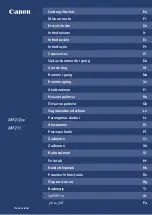
22
Chapter
1
Protocols and Emulations
•
Dataproducts Adapter:
Supplies a 50 pin AMP Amplimite HDH-20 data cable connector. This
feature is necessary if you are using the Dataproducts parallel protocol.
•
Ethernet Interface:
Enables you to attach your printer to Local Area Networks using Ethernet
protocols. The Ethernet Interface functions as a workstation server on
your network, enabling your users to submit print jobs to your printer.
•
Power Paper Stacker:
Mechanically directs the paper from the printer to the paper stacking area.
This feature provides consistent paper handling with fewer paper jam
errors.
•
Input Paper Shelf:
Pedestal model only. Provides a shelf to hold a box of paper or forms.
This is a convenient feature if you need to move the printer often.
•
Pull Out Tray:
Cabinet model only. A tent tray to hold printed papers or forms that you
can pull out for accessiblity.
•
Wireless:
An embedded wireless Ethernet Interface card that allows you to attach
printers on a local area network (LAN) rather than attaching them directly
to a host system.
Protocols and Emulations
A
protocol
is a set of rules governing the exchange of information between the
printer and its host computer. These rules consist of codes that manipulate
and print data and allow for machine-to-machine communication. A printer
and its host computer must use the same protocol. As used in this manual,
protocol
and
emulation
mean the same thing.
Most impact printers are single ASCII character codes to print text, numbers,
and punctuation marks. Some characters, both singularly and in groups are
defined as control codes. Control codes instruct the printer to perform specific
functions, such as underlining text, print subscripts, setting page margins, etc.
The main difference between most printer protocols is in the characters used
to create control codes and the ways in which these characters are formatted.
When the printer executes the character and control codes of a particular
printer protocol, it is “emulating” that printer. If the printer uses the Proprinter
III XL protocol, for example, it is emulating an IBM Proprinter III XL printer.
If the printer is using the Epson FX printer protocol, for example, we can also
say it is in Epson FX emulation mode.
There are additional emulations that are provided as optional features, such
the Code V and IGP emulations. For additional information, refer to “Code V
Feature (VGL)” on page 175 and “IGP Feature (PGL)” on page 169.
Содержание 6500 Series
Страница 2: ......
Страница 6: ......
Страница 24: ...24 Chapter 1 Taking Care of Your Printer ...
Страница 56: ...56 Chapter 3 Changing the Power on Configuration ...
Страница 214: ...214 Chapter 4 Printer Information Menu ...
Страница 230: ...230 Chapter 5 IEEE 1284 Parallel Interface ...
Страница 304: ...304 Appendix B Printing Speed ...
Страница 310: ...310 Appendix C Compatibility and Limitations ...
Страница 334: ...334 Communication Statements ...
Страница 358: ...358 ...
Страница 359: ......
Страница 360: ...Printed in U S A S550 1335 03 07S550133503 ...
















































